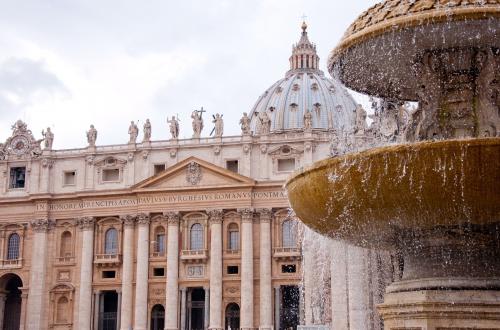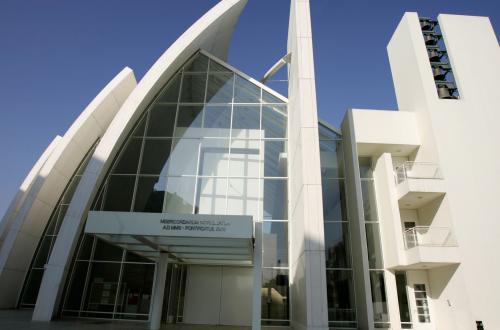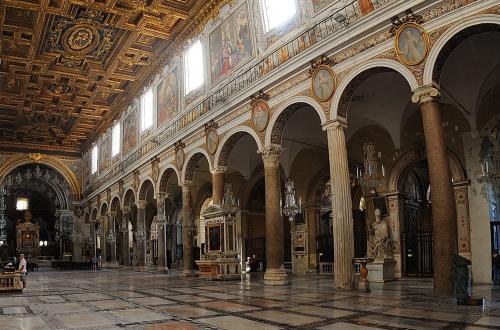Vatikanische Basilika St. Peter

 Condividi
Condividi
It was built to a design by architect Gino Cancellotti.
What is the meaning of the term Valme?
The name in Panfilo comes from the catacombs of San Panfilo on which the church is built, catacombs consisting of several tunnels where pilgrims' graffiti and funerary inions can be found.
The parish was established on 3 September 1960, with the decree of Cardinal Vicar Clemente Micara Paterna sollicitudine, and entrusted to the diocesan clergy of Rome, in the person of Fr Sisto Gual
[...]The parish of St Bartholomew the Apostle is located in the Tomba di Nerone district, in the north-west of Rome, near the GRA and falls within the Western Sector of the diocese of Rome.The area in w
[...]It was built to a design by architect Augusto Baccin and consecrated by Cardinal Luigi Traglia on 22 December 1963.The church is a parish seat, established by Cardinal Vicar Clemente Micara on 17 J
[...]In 1912 Pius X wanted to have a church built in the Ostiense district, near the gasometer, to provide for the spiritual life of the people living there, but he died before he could see the work beg
[...]San Bernardino in Panisperna or Panispermia or San Bernardino ai Monti or San Bernardino da Siena ai Monti is a small Roman Catho
[...]It was established as a vicarage on 1 October 1974 and elevated to parish status on 10 November 1978 by decree of Cardinal Vicar Ugo Poletti.
The church was built on the Campidoglio during the Middle Ages (before 1192) on the ruins of an insula dating back to the second century and its construction seems to be attributable to the Boccabe
[...]It is dedicated to St Bonaventura da Bagnoreggio (1221-1274), a Franciscan father who later became the general minister of the order.
The parish of St.
Of ancient origins, according to tradition it is built on the house where Pope Callistus I (217-222) used to retire to pray and where he suffered martyrdom by drowning: in the courtyard of the form
[...]The church was built at the behest of Pope Pius X to the design of architect Tullio Passarelli. Construction began in 1906, and the foundation stone was laid by Cardinal Antonio Agliardi.
In the church of San Carlo Borromeo, designed by the Milanese studio Monestiroli Architetti Associati, the first recognizable element is the large tower located in correspondence with the presbyter
[...]The parish of St Charles of Sezze is the result of an extraordinary intervention of Divine Providence.It all started with the inspiration to build a centre for young people.
L'edificio è dedicato a San Celso, martire ad Antiochia nel 302 d.C., ma è conosciuta come San Celsino per distinguerla dalla vicina chiesa dei SS.Celso e Giuliano.
The present church was built by architect Fiessa and the Vigevano company.
It was built in 1994-1995 to a design by architect Savelli and consecrated by Cardinal Camillo Ruini on 25 April 1996.The church is a parish seat, erected on 25 July 1965 with the decree of Cardina
[...]The parish was established on 20 October 1989 under the name of St.
Essa fu costruita su progetti dell'architetto Pasquale Carbonara nel 1969.
It was built in the 20th century.
The building was constructed between 1934 and 1935, designed by architects Mario Paniconi and Giulio Pediconi, and consecrated on 2 October 1941 by Cardinal Luigi Traglia.The church is a parish sea
[...]Established as a vice-curia on 7 December 1956, declared dependent on the Parish of St.
The church is located in the monastery of the Filipino Oblate. It was built by G.B. Cantini who incorporated the ancient villa of the Sforza family.
The parish was erected on 10 May 1934, with the decree of Cardinal Vicar Francesco Marchetti Selvaggiani Quo melius, which transferred the rights and revenues of the suppressed parish of S.
It was built, to a design by architect Pier Luigi Maruffi, between 1952 and 1955, at the suggestion of the then Substitute to the Secretariat of State of the Holy See Giovanni Battista Montini, the
[...]Also known by the name of Sant'Onofrio in Campagna al Borgo Clementino, it was built to a design by Pietro Passalacqua between 1667 and 1676, thanks to a bequest by Bartolomeo Neri, prothonotary ap
[...]
 Condividi
Condividi

 Condividi
Condividi

 Condividi
Condividi

 Condividi
Condividi